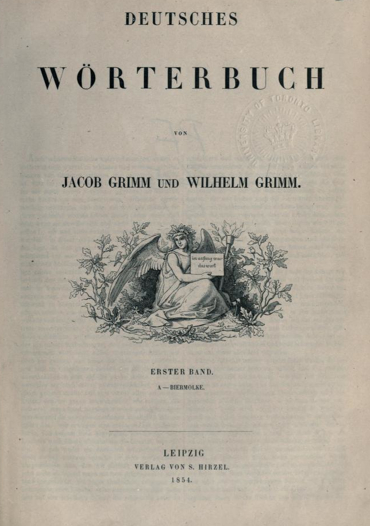Disclaimer: The sole purpose of this article is to provide content for the sample encylopaedia. There is no claim to completeness or correctness.
The Deutsches Wörterbuch (DWB, German Dictionary) is the largest and most comprehensive dictionary of the German language with word meanings and references, compiled since the 16th century. It is also referred to as Der Grimm (The Grimm) because it was the brothers Jacob Grimm ![]()
 and Wilhelm Grimm
and Wilhelm Grimm ![]()
 who started the DWB in 1838. After 123 years, in 1961, it was finally finished. A total of 32 volumes were produced. The revision began at the same time as the work on the first edition was completed. 1Deutsches Wörterbuch, https://de.wikipedia.org/wiki/Deutsches_W%C3%B6rterbuch[16.12.2020] An electronic version of the DWB (Der Digitale Grimm) has been compiled by Trier University since 1998, was published on CD-ROM and has been accessible as an online version since June 2002.2http://dwb.uni-trier.de/de/ and http://woerterbuchnetz.de/cgi-bin/WBNetz/wbgui_py?sigle=DWB [16.12.2020]
who started the DWB in 1838. After 123 years, in 1961, it was finally finished. A total of 32 volumes were produced. The revision began at the same time as the work on the first edition was completed. 1Deutsches Wörterbuch, https://de.wikipedia.org/wiki/Deutsches_W%C3%B6rterbuch[16.12.2020] An electronic version of the DWB (Der Digitale Grimm) has been compiled by Trier University since 1998, was published on CD-ROM and has been accessible as an online version since June 2002.2http://dwb.uni-trier.de/de/ and http://woerterbuchnetz.de/cgi-bin/WBNetz/wbgui_py?sigle=DWB [16.12.2020]
Beginnings and first volumes
In 1838, the philologist Moritz Haupt and the publisher Karl Reimer succeeded in winning over Jacob and Wilhelm Grimm for the project of a large New High German dictionary. The purpose of the dictionary was to present the High German written word inventory in its development and use from the middle of the 15th century to the present day. 3The overview of the history of the DWB is based on “The German Dictionary by Jacob Grimm and Wilhelm Grimm”, http://dwb.uni-trier.de/de/das-woerterbuch/das-dwb/ [16.12.2020] Between 1838 and 1847, the Grimm brothers began to build up an archive of some 600,000 documents from the fine literature and older specialist and non-fiction literature for the vocabulary from A to Z. When they started the editorial work on the Deutsches Wörterbuch (DWB) in 1849/50, they estimated its size at six to seven volumes and the working time at ten years. In fact, in more than a hundred years, 16 volumes in 32 sub-volumes have been published, with more than 300,000 keywords, as well as a separate list of sources comprising some 4,000 sources. The DWD inspired other historical lexicography projects, such as the Oxford English Dictionary (OED), edited by James A. Murray and first published by Oxford University Press. 4https://en.wikipedia.org/wiki/Oxford_English_Dictionary [16.12.2020]
On May 1, 1852 the first fascicle [A – Allverein] was published for the Leipzig Spring Fair, and on April 13, 1854 the first volume [A – Biermolke] was published, now by S. Hirzel Verlag as the successor to Weidmannsche Buchhandlung. Wilhelm Grimm died on December 06, 1859, Jacob Grimm died on September 20, 1863; up to this date the keywords “A” up to and including “Frucht” (fruit) had been edited. The work on the dictionary was continued by Rudolf Hildebrand and Moritz Heyne, among others. Until 1900 about 50% of the German vocabulary could be edited.
Completion in the 20th century
In 1908, the Deutsche Kommission der Königlich-Preußischen Akademie der Wissenschaften zu Berlin (German Commission of the Royal Prussian Academy of Sciences in Berlin) finally took over the scientific management of the dictionary. Since 1921, the financing of the DWB was partly taken over by the Notgemeinschaft der deutschen Wissenschaften (later Deutsche Forschungsgemeinschaft, DFG), and the preparation of the outstanding volumes was institutionalised by establishing a permanent office in Berlin in 1930 and in Göttingen in 1947. In 1961 the last volume was published and in 1971 the work was completed with the publication of the list of sources as the 33rd volume. In 1984 the DWB was published as a paperback by the dtv publishing house. Since 1965, a new edition of parts A – F has been published by the Berlin-Brandenburgische and Göttinger Akademie der Wissenschaften.
Impact of the DWD
“The lack of a dictionary concept that is fundamental to all volumes and its long history, which is shaped by the ideas and preferences of the respective editors and the latest findings in linguistics, philology and history, make the DWB an extremely heterogeneous work. But it is also associated with over one hundred years of institutional history, which at the same time reflects over one hundred years of political, linguistic and lexicographical history. This makes the DWB not only a basic work of the history of the German language, but also an incomparable testimony of scientific theories, procedures and methods of the 19th and 20th centuries, which is still of great interest to many people.” 5Own translation from http://dwb.uni-trier.de/de/das-woerterbuch/das-dwb/ [16.12.2020]

